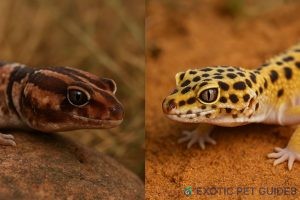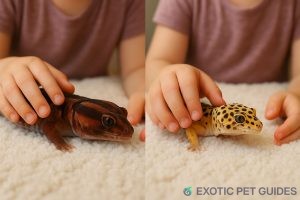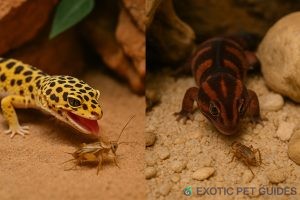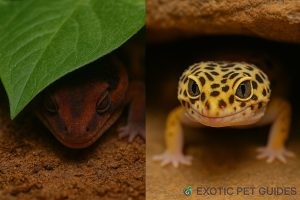🧭 Introduction
African Fat-Tailed Geckos (Hemitheconyx caudicinctus) and Leopard Geckos (Eublepharis macularius) are two of the most beginner-friendly reptiles in the hobby. While they may seem similar at first glance — both small, terrestrial, insect-eating, and easy to care for — they have several key differences.
If you’re trying to choose between the two, this article breaks down their:
- Appearance
- Behavior
- Care needs
- Pros & cons for new owners

🎨 Appearance & Color
| Feature | Fat-Tailed Gecko | Leopard Gecko |
|---|---|---|
| Body Shape | Chunky body, short snout | Slimmer, pointed snout |
| Tail | Fat, rounded tail (shorter) | Long, tapered tail |
| Eyes | Darker, more almond-shaped | Larger, often spotted |
| Skin Texture | Smooth | Bumpy |
| Color Variants | Natural browns, some morphs | Huge range of morphs & patterns |
🧠 If you want a gecko with natural earthy tones, go with the Fat-Tail. If you want wild patterns and colors, Leopard Gecko wins.
🧠 Temperament & Handling
Both species are docile and easy to handle, but Fat-Tails are generally even calmer.
| Trait | Fat-Tailed Gecko | Leopard Gecko |
|---|---|---|
| Handling tolerance | Excellent | Excellent |
| Movement | Slow, deliberate | Slightly more active |
| Behavior when startled | Freezes or hides | May bolt or vocalize |
| Ideal for children? | Yes (with supervision) | Yes |

🌡️ Habitat Requirements
While both are terrestrial geckos, Fat-Tails come from more humid environments.
| Setup Factor | Fat-Tailed Gecko | Leopard Gecko |
|---|---|---|
| Tank Type | 20-gallon long (horizontal) | |
| Heating | UTH preferred | UTH or overhead lamp |
| Humidity | 50–70% (humid hide required) | 30–40% (dry) |
| Substrate | Paper towel, coconut fiber | Paper towel, tile, reptile carpet |
🌿 Fat-Tails are more sensitive to dry air and need proper humidity control to shed properly.
🦗 Diet & Feeding
Both are insectivores, and their feeding routines are nearly identical:
- Crickets, roaches, worms
- Gut-loaded insects
- Calcium + vitamin dusting
- No need to feed vegetables or fruit

🩺 Health & Longevity
| Feature | Fat-Tailed Gecko | Leopard Gecko |
|---|---|---|
| Lifespan | 15–20 years | 15–20 years |
| Common Health Issues | Shedding problems (if too dry) | |
| Tail Drop Frequency | Moderate | Moderate |
| Lighting Requirement | No UVB required (optional) |
✅ Both species do fine without UVB, but can benefit from low-level UVB in well-planned setups.
✅ Pros & Cons Comparison
| Trait | Fat-Tailed Gecko | Leopard Gecko |
|---|---|---|
| Handling friendliness | ⭐⭐⭐⭐ | ⭐⭐⭐⭐ |
| Beginner setup simplicity | ⭐⭐⭐ | ⭐⭐⭐⭐ |
| Morph/color variety | ⭐⭐ | ⭐⭐⭐⭐⭐ |
| Humidity management needed | ⭐⭐⭐⭐ (yes) | ⭐ (no) |
| Shyness | ⭐⭐⭐⭐ (more shy) | ⭐⭐ (more confident) |

🧬 Which Gecko Is Right for You?
Choose the African Fat-Tailed Gecko if you:
- Want a calm, relaxed pet
- Prefer natural colors
- Can maintain moderate humidity
Choose the Leopard Gecko if you:
- Want a variety of morphs
- Prefer a drier, simpler setup
- Like a more outgoing lizard
Either way, both are fantastic beginner pets that are low-maintenance, hardy, and rewarding.